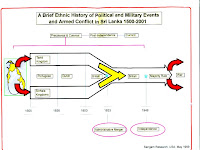A Brief Colonial History Of Ceylon(SriLanka)
Sri Lanka: One Island Two Nations
A Brief Colonial History Of Ceylon(SriLanka)
Sri Lanka: One Island Two Nations
(Full Story)
Search This Blog
Back to 500BC.
==========================
Thiranjala Weerasinghe sj.- One Island Two Nations
?????????????????????????????????????????????????Friday, May 4, 2018
SELECTIVE MEMORY: ERASURE & MEMORIALISATION IN SRI LANKA’S NORTH
Image: Exhibition by the Geneva lake side, April, 2018. (c) s.deshapriya.
 03/05/2018
03/05/2018
(CPA, Colombo, Sri Lanka) The insurrections of the 1970s, the riots of 1983 and the 30-year conflict – all which have immeasurably shaped the country’s history and have far more reaching consequence for its future – are glaringly absent from the history syllabus of the Sri Lankan education system. Textbooks are one way of teaching history and memorialisation. So too are the physical expressions of history and of memory, in the monuments we have built to tell the stories of our past. As with the lessons that we teach the younger generations, the Sri Lankan State’s practice is selective here too.
(CPA, Colombo, Sri Lanka) The insurrections of the 1970s, the riots of 1983 and the 30-year conflict – all which have immeasurably shaped the country’s history and have far more reaching consequence for its future – are glaringly absent from the history syllabus of the Sri Lankan education system. Textbooks are one way of teaching history and memorialisation. So too are the physical expressions of history and of memory, in the monuments we have built to tell the stories of our past. As with the lessons that we teach the younger generations, the Sri Lankan State’s practice is selective here too.
From schoolbooks to statute and statues, this erasure of the country’s
violent recent history is reflective of deliberate State amnesia on the
part of successive governments and a convenient approach to dealing with
the past – without confronting its horrors – by way of denial. The
atrocities witnessed, especially by those living in the combat zones of
the Northern Province, and the drastic losses faced by the communities
have been reduced to monuments that tell only one, partial story – that
of the glorious victories of the armed forces.
The monuments do not account for the multiple narratives and truths
around experiences of the conflict. The State-sponsored memorials were
not built with any consultation from the communities that live in the
immediate vicinity. Communities whose histories are linked to these
places and what they were before the conflict, and whose everyday
realities are linked to these places and what they are after the
conflict.
For people from the South in general, it may be difficult to understand
why these memorials are so out of place and violent. For the people
living around them, the monuments are a living reminder of the painful
recent past which prevent them from ‘moving on’ in any sense.
The impact of these memorials is inextricably linked to the patterns of militarization and land occupation that remain in the Northern Province,
eight years after the conflict came to an end. Taking into
consideration the ground realities that persist for residents of these
areas, issues that have gone unaddressed by several governments,
sustained marginalization of this nature, if left unaddressed, has the potential to fuel renewed cycles of conflict.
Access this story made on Microsoft Sway here or view the embed below.
